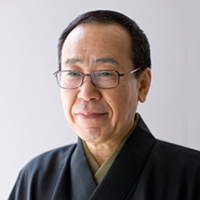Tie-dyed formal kimono "Taiyo-Fu"
- Textiles
- Presented in 2015
- Not for Sale
| Category | Textiles |
|---|---|
| Year Presented | 2015 |
| Exhibition | The 62th Japan Traditional Kōgei Exhibition |
-
Shibori tie-resist dyeing
For shibori tie-resist dyeing, artisans use string to tightly tie, stitch, or fold fabric to prevent the dye from penetrating parts of the cloth. Unlike yūzen dyeing, in which the dye is applied using brushes or pastes, the designs for shibori are created by immersing the cloth in dye. The bound portions remain undyed and produce pleasing color gradations. Tie-resist dyeing is Japan’s oldest dyeing technique. Over one hundred shibori techniques continue to be practiced today, including fawn spot (kanoko shibori), stitch resist (nuishime shibori), and capped resist (bōshi shibori).
Atsushi Ogura

Shibori (tie-dye) is dyeing colors and white separately. The shiborizome technique has been used in Japan for more than one thousand several hundred years. The colored parts make the white stand out brightly, while the white parts make the colors stand out beautifully. The white parts are not simply just non-dyed parts. The colors and the white resonate with each other and with the patterns and become a beautiful piece of art. I use the shiborizome techniques in all of my kimonos.

